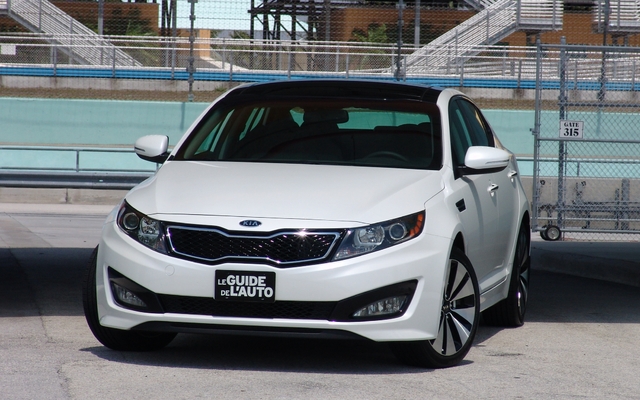2012 Kia Optima: The Magentis’ replacement at a glance

The all-new Kia Optima is replacing the relatively unknown Magentis. The soporific lines have been brushed aside with a better design. This is just as true on the inside the car, as the interior earns as many gold stars as the exterior. What’s more, the very modern design doesn’t compromise functionality. Even though the roof is quite arched in the rear, there’s still enough headspace for all passengers. And the cabin is spacious for a car in this category, which includes the Toyota Camry, Honda Accord and Ford Fusion.
In terms of the mechanics, two engines are available. First, there’s the 2.4-litre four-cylinder engine that produces 200 horsepower and 186 lbs-ft of torque. It’s paired with a six-speed manual gearbox on the basic version, and a six-speed automatic on the other versions (available on option on the basic model). Kia has posted the fuel consumption at 8.7 L/100 km in the city and 5.7 on the highway. But you should know that we weren’t able to verify these figures during the test drive. This engine is OK, but it lacks punch under 3,500 rpm.
The other engine, a four-cylinder turbo with direct fuel injection delivers 274 horsepower and 269 lbs-ft of torque. It’s married to a six-speed automatic transmission. Though it hardly turns the Optima into a Posche 911 Turbo, it certainly improves its handling, especially during sporty driving.
On the highway, the new Optima demonstrates excellent manners. The chassis, which is the same as on the Hyundai Sonata, is rigid, the steering is precise enough and the suspension, which is firmer than that of its Hyundai sibling, ensures more dynamic road hadling without being uncomfortable.
The Optima equipped with the 2.4-litre engine (the LX and EX) should roll into Canadian dealerships over the next few days. The price varies from $21,999 to $30,595. The Turbo version (the SX) is expected a few weeks later and will cost $33,695.









